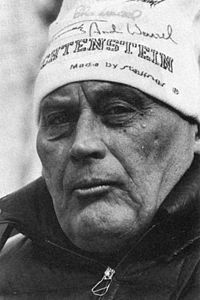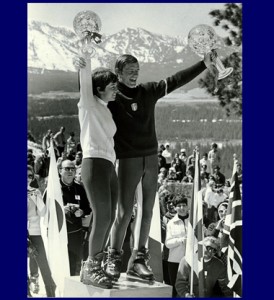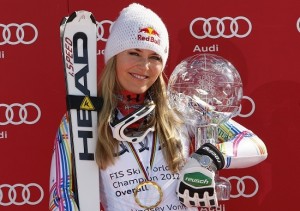Skiing started in Europe long before the United States got into the act. The early U.S. ski industry including ski areas relied heavily on transplanted Europeans. There are still more than twice as many skiers in Europe than here in the United States. So it’s not surprising that competitive skiing got its start in Europe.
The Federation Internationale de Ski, the FIS., was organized in 1924 at Chamonix, France and is the governing body for ski competition. From the original 14 member countries it has grown to 111 world-wide members today.
Alpine ski competitions became a matter of national pride among the European countries. Individual racers were well-known sports figures. The races attracted spectators whose numbers grew as the years passed. The Hahnenkamm downhill race in Austria started in 1931 and today it draws almost 100,000 spectators with tickets going for over 100 Euros each.

Serge Lang
Serge Lang was a French journalist who liked to ski. He covered alpine skiing and cycling for various French publications. In 1965 his editor at L’Equipe challenged him to come up with something to “help readers understand the ski racing alpine circuit.” They implemented a “Trophee de L’Equipe” which was presented to the man and woman who had the best overall results for the 1965-66 European races.
During that season Lang had discussions with Honoré Bonnet, the French ski coach, and Bob Beattie, Director of the United States Ski Team. They felt that while the trophies were a good idea, the concept should be extended beyond Europe to the world. There should be a world-wide circuit of ski races and awards would be given for the best overall performances.

Jean-Claude Killy and Nancy Greene celebrate their World Cups
Lang took the idea to the head of the FIS and also several of the leading racers of that day. The first World Cup race was held on January 5, 1967 at Berchtesgaden, Germany. At the end of the season the first World Cups were presented to Jean-Claude Killy of France and Nancy Greene of Canada.
There were no answers submitted for last week’s trivia question. Sad to say that reflects the level of interest shown for the World Cup here in the United States. Even though this year a very photogenic American came close to achieving the maximum possible points in attaining her fourth overall World Cup!
However Lang’s idea caught on in Europe with both fans and racers. Lang stayed involved with the World Cup first informally and then serving as President of the FIS World Cup Committee from 1973-1986. Lang also published the annual Ski World Cup Guide which contained World Cup statistics and racer biographies.
Over the years the World Cup circuit has visited 25 countries living up to its “world” title. While the races have been global, the World Cup winners have predominantly come from either Austria(24) or Switzerland(18). Surprisingly the United States is third having collected 10 World Cups which is more than traditional European powers such as France and Germany.

Lindsey Vonn with her Fourth World Cup
Phil Mahre won three World Cups and Bode Miller has won two with the most recent being in 2008. Lindsey Vonn’s win this year was her fourth. The other women’s winner would make a very difficult trivia question, but it was Tamara McKinney in 1983. That year was also one of Phil Mahre’s wins so the United States collected both men’s and women’s.
World Cup winners get “rock star” status in Europe even when the winner isn’t from Europe. European press follows the World Cup circuit and coverage appears on the sports pages, the news pages, and even the gossip pages. At the 2006 Torino Olympics, the U.S. media were critical of Bode Miller’s less than stellar Olympic performance. Part of Bode’s intransigence was because of that same media’s lack of interest in his World Cup win the previous year.
Serge Lang died in 1999, but his World Cup lives on to assure his place in skiing history. The 2012 men’s World Cup was not decided until the last race of the season this past weekend. Thirty thousand Austrians cheered countryman Marcel Hirscher to a Giant Slalom win in Schladming, Austria, which allowed him to pass Swiss racer Beat Feuz in the overall cup standings. Serge would have loved that kind of ending.

Leave a Reply